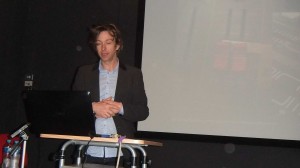Meeting Report
Sound Level Management – A Ground-Up Approach
– Dr Johannes Mulder (Murdoch University) –
On Monday August 29th, AES Melbourne members and guests assembled in the SAE Melbourne Lecture Theatre to hear Murdoch University’s Johannes Mulder present on “Sound Level Management – A Ground-Up Approach”
Jos started by introducing himself, describing his Master’s Thesis on Jazz at the Concertgebouw in Amsterdam, and his experiences with the challenges of live amplified performances in a classical music venue with a long reverb time.
He then described his experience as a Production Manager at Concertgebouw, where he was able to negotiate with the musicians to keep stage levels under control to maintain intelligibility.
He then covered the Hearing Covenant in the Netherlands, established in 2011 – which required an Leq of 103dBA over 15mins, noting that several other European countries have since added similar recommendations. (Eg: Belgium with Leq=100dB(A) over 60min and ‘headroom’ Leq of 102db(A) over 15min, and Germany with Leq=99dB(A) over 120min and 102dB(A) over 30min)
He then introduced us to some software packages – MeTrao, and 10eazy – which enable the monitoring of levels over time and facilitate “dB banking” where higher level periods can be offset by lower level periods to maintain compliance.
Jos suggested that short term measurement requires short term engagement (as in policing) but averaged term monitoring (eg over a period at least 15min) promotes a dialogue between the parties, and the software facilitates this.
He went on to describe a typical conflict situation when levels are measured and are not managed, ending in a “yell-fest” with neither party feeling their needs could be met.
He then described the SoundCheck Symposium he organized in Melbourne in 2015, where he drew together practitioners (musicians and engineers) and academics to discuss developments in the Sound Level Management field(1).
This followed on to a description of the Hearsmart CRC (Cooperative Research Centre) (2)
and their Know Your Noise initiative (3)
He then mentioned his involvement in the 2015 AES Noise Induced Hearing Disorders Conference, which ultimately led to the publication of his paper Amplified Music and Sound Level Management in the March 2016 Journal of the AES.
He also covered the issues that live sound engineers face in achieving a good sound at acceptable levels, and commented that there seemed to be a trend currently for bass-heavy live mixes.
One intriguing issue he raised was the often-neglected contribution of audience participation (singing, cheering, screaming) to overall concert sound levels.
Jos then described regulations and how they apply, with one potential anomaly being OH&S – which is limited to venue staff – not musicians and sound engineers.
He then outlined work yet to be done, looking at Loudness and Tod and Cody’s theory of a Rock&Roll threshold in which enjoyment of loud rock music is a physiological effect triggered by stimulation of the saccule in the ear (4) (5)
He also asked if it was time to move on from measurements using the dB(A), suggesting that work needed to be done on identifying a replacement – maybe dB(C) or the broadcast-oriented LUFS and K-Weighting.
He also mentioned Durbridge’s 2015 work on the relationship between loudness perception and distortion (6), and the role of limiters (and the distortion they introduce) in the perception of loudness.
In calling for better training of live-sound engineers, Jos suggested that a certification requirement, along the lines of our local Responsible Serving of Alcohol Certificate, would be useful to ensure practitioners were trained in Sound Level Management.
An extended Q&A session following the presentation.
We thank Jos for travelling from Perth to present to us on this important topic.
Here’s the slides with audio:
This video can also be viewed directly on YouTube at:
https://youtu.be/bLnR0uYjklE
The slides only as a downloadable PDF can be accessed here.
-and-
The audio-only recording can be heard or downloaded here.
A special thanks to the SAE Institute for allowing us the use of their fine facilities.
References:
- http://soundchecksymposium.murdoch.edu.au/
- http://hearsmart.org/
- http://knowyournoise.nal.gov.au/
- http://scitation.aip.org/content/asa/journal/jasa/107/1/10.1121/1.428317 (abstract)
- http://www.nature.com/news/2000/000107/full/news000113-2.html
- http://derby.openrepository.com/derby/handle/10545/583125 (abstract)

